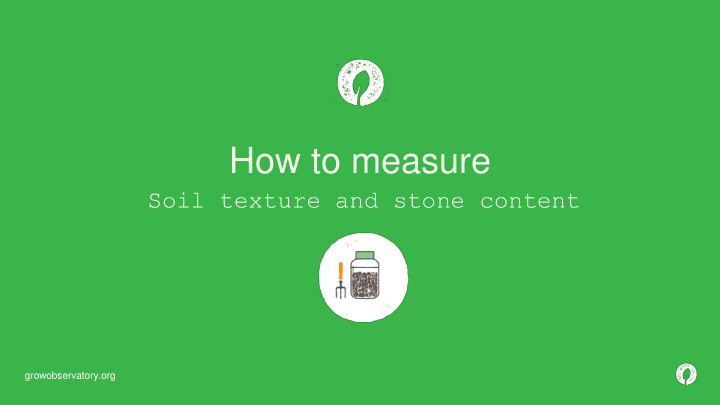



How to measure Soil texture and stone content growobservatory.org
You need: • A glass jar • A trowel • A spade • Some paper • A 2mm sieve • A mortar • A permanent marker • A ruler • A teaspoon of SHMP Sodium hexametaphosphate ) growobservatory.org
The jar must be The jar must have flat sides down to the bottom – as flat as possible. 13 cm tall, or taller. growobservatory.org
The diameter of the jar must be min. 8-9 cm. growobservatory.org
Step 1 Prepare your jar growobservatory.org
• Make a 3cm mark and a 13cm mark from bottom up. • Label 3cm mark “soil” and the 13cm mark “water”. • If your jar is about 13cm tall in total, label lid with “13cm water”. growobservatory.org
Step 2 Dig your soil growobservatory.org
20cm 20cm Dig a hole 20 cm in diameter and 10-15 cm deep. growobservatory.org
• Take out the soil and set aside. • Cleanly cut one side of the hole so that it is smooth and evenly vertical. growobservatory.org
10 10-15 15cm cm Clean side with your hands. growobservatory.org
Step 3 Estimate stone content growobservatory.org
Estimate stone content visually with help of diagrams. Or take out soil from the wall and estimate stone content visually 10cm 10cm with help of diagrams and by touching. growobservatory.org
First, eliminate the options that seem the least likely. Then, weigh the other options and decide on your final approximate estimate. growobservatory.org
Step 4 Soil sampling growobservatory.org
Take a large enough soil sample from the dug-up pit, from between 5-15cm depth. Large enough depends on the size of your jar and on how many stones and debris are in your soil. Once stones and debris are removed, you should be able to fill your jar with compressed soil up to the 3cm mark. 2 soil samples from 2 different spots in northern Austria growobservatory.org
Dry the soil first, especially if you When dry, separate soil particles until there are no crumbs left – with a mortar or a have wet, dense and heavy soils. similar tool. growobservatory.org
! IMPORTANT – be very gentle, do not break apart stones or grind smaller particles! growobservatory.org
Step 5 Sieve soil and revisit stone content growobservatory.org
Sieve the separated soil particles through a 2mm sieve and revisit stone content estimates. Soil sample 1 Soil sample 2 growobservatory.org
Fill your jar with the soil, compress, up to the 3cm mark. growobservatory.org
Step 6 Fill with water and make solution growobservatory.org
Fill the jar with water: • completely (13cm jars) or • up to the 13cm mark (>13cm jars). Close the lid and shake firmly! growobservatory.org
After shaking, you may now see a gap between the 13cm mark and the water level in the jar. Close the gap by filling with water. growobservatory.org
Remove floating organic matter and debris. Add a teaspoon of SMHP, stir well, close the lid and firmly shake again. growobservatory.org
…, where you can access it easily When finished, bring the jar and where it can sit for a couple of some- where,… days. growobservatory.org
Step 7 Explore how sediment settles growobservatory.org
Let sit for 3 days and shake firmly at least twice a day. This helps completely dissolve the smallest soil particles. After shaking the jar every day, you can observe and get an idea on how the different components of your soil settle with different speeds. growobservatory.org
Slightly tilt your jar backwards to better see the line between the first layer to settle (sand) and the other particles, which are still dissolved in the water. growobservatory.org
Or rotate the jar horizontally to explore the line between the settled layer and the remaining soil solution. growobservatory.org
Step 8 Measure and record sediment layers growobservatory.org
After three days of shaking, firmly shake your jar one last time and place on an even surface. Do not move the jar from now on. Wait 2 minutes until the SAND layer has settled. Mark level of sand. growobservatory.org
Now, let sit in an even spot for 5 hours. Wait 5 hours until the SILT layer has settled. Mark level of silt. growobservatory.org
The silt layer may compresses further after 5 hours. If you can observe this, correct the silt mark. growobservatory.org
Now, let sit in an even spot for at least 24 hours for the CLAY layer to settle. If the water is still cloudy after 24 hours, wait longer. growobservatory.org
When water is clear, make final mark for level of clay. Note that the water is dark but clear in the right jar. growobservatory.org
Measure the height of each layer in mm. SAND (from bottom up) SILT (from sand to silt mark) CLAY (from silt to clay mark) growobservatory.org
Step 9 Record your results growobservatory.org
SOIL TEXTURE STONE CONTENT Sand: _______mm 0% 1-5% Silt: _______mm 6-15% 16-40% Clay: _______mm 41-80% >80% growobservatory.org
Congratulations, you’ve successfully measured soil texture and stone content!
Recommend
More recommend